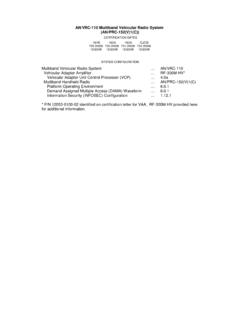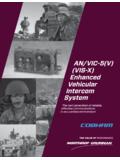Transcription of 24 GHZ SHORT-RANGE MICROWAVE SENSORS …
1 Workshop short Range Radar , TU Ilmenau, July 15-16, 1999. 24 GHZ SHORT-RANGE MICROWAVE SENSORS . FOR INDUSTRIAL AND vehicular APPLICATIONS. P. Heide 1, M. Vossiek 1, M. Nalezinski 1, L. Or ans 2, R. Schubert 3, M. Kunert 4. 1. SIEMENS AG, Corporate Technology, D-81730 Munich / Germany 2. SIEMENS AG, Automation and Drives, D-76181 Karlsruhe / Germany 3. SIEMENS AG, Transportation Systems, D-12424 Berlin / Germany 4. SIEMENS AG, Automotive Systems, D-93055 Regensburg / Germany Abstract MICROWAVE SENSORS are well suited for robust non-contact measurements of distance and velocity. The use of radar technology in sensor applications is steadily increasing [1]. The higher the radar frequency, the better the resolution and the smaller the size of the sensor. This paper gives a status report on the development of 24. GHz SHORT-RANGE radar SENSORS for industrial and vehicular applications.
2 System and technology aspects are considered. Several commercial radar systems are presented. A. Industrial Tank Level Measurement radar The measurement of level in tanks (see fig. 1) is a significant indus- level trial market [2]. The process control industry needs to measure the gauge level of a wide range of different products stored in tanks throughout distance chemical and pharmaceutical plants, power plants, oil refineries, pulp multiple and paper mills and cement mills. The industrial customer prefers traverse echo level instruments with capabilities like wide application range (different materials and tank geometries, water diverse environmental conditions) inlet high reliable, repeatable and accurate measurement easy installation, operation and maintenance liquid level self-calibration and self-diagnosis process not to be influenced by the measurement; instrument to be installed in existing tank opening Traditional level instruments ( float gauges, capacitance probes, difference pressure transmitters) require a mechanical contact to the process.
3 These SENSORS have several limitations regarding to the diver- Fig. 1 Radar tank level se process conditions ( corrosive media and changes in density, measurement. pressure, dielectric constant, temperature). MICROWAVE technology has proved to be well suited for tank level measurement, due to the non-contact sensing principle, its reliability in a wide measuring range and its robustness against temperature, pressure, steam and dust. The market share of radar level gauges increases steadily. Most of today's radar systems operate at GHz or 10 GHz [3]. However, the next product generation will use 24 GHz technology [2,4] because of two main reasons: A 24 GHz level gauge is smaller and easier to handle it provides higher sensitivity, reliability and accuracy. The radar propagation with respect to reflection and absorption of the tank media is not significantly different at , 10 or 24 GHz.
4 The main impact on the radar performance comes from the antenna directivity and the radar bandwidth and here 24 GHz technology provides distinct benefits: 1. Sharp antenna patterns are feasi- ble (even with small antennas) and 2. the possible higher modulation bandwidth allows to obtain a good axial resolution ( the ability the separate two closely spaced echoes). As a result, the narrow antenna beam and page 1/6. Workshop short Range Radar , TU Ilmenau, July 15-16, 1999. the high axial resolution make the 24 GHz level gauge conical horm antenna, 3dB-width in H plane 3dB- less susceptible to false returns from obstructions like width [deg]. agitator blades, inlet valves and ladders. The directivity is proportional to the antenna diameter and inverse proportional to the radar wavelength. A 24. GHz antenna achieves the same directivity pattern with GHz a quarter of the antenna diameter compared to GHz (see fig.)
5 2). Thus, 24 GHz level gauges provide more 10 GHz flexibility, because they fit into narrow tank flanges 24 GHz even when located at the side of the tank. In spite of these significant advantages, 24 GHz SENSORS were barely applied in the level industry up to now due to a lack of technical maturity and the high cost of the diameter of antenna [mm]. MICROWAVE components. The new Siemens radar level Fig. 2 Antenna directivity as a function gauge SITRANS-LR overcomes these limitations by an of antenna diameter. innovative approach. Siemens 24 GHz Tank Level Gauge A FMCW radar concept has been chosen, which is advantageous with respect to the applicability of advanced digital signal processing. The schematic of the sensor electronic is shown in fig. 3. The frequency modulation is realized with a GHz VCO controlled by a ramp generator (FGEN). One part of the VCO signal is fed to the reference block comprising a SAW (surface acoustic wave) delay line and an IF mixer (IMIX) yielding a reference signal (REF).
6 The transmitted 24 GHz signal is generated by an upconversion of the GHz FM. signal. The SSB upconverter comprises a highly stable GHz local ocillator (LO), a mixer (TXMIX) and a filter/amplifier (BP,AMP). The 24 GHz receiver (RXMIX) diplexes the transmit and receive signals, down- converts them with a single-balanced mixer and provides the target signal (MEAS) to be processed in the digital signal processor (DSP). The strategy behind the applied concept was to reduce the complexity of the sensor electronic by realizing cri- tical functions at the IF or the software level rather than at 24 GHz. The reference signal (REF), that is a replica of the transmitted radar signal, is used to calibrate the sensor. The calibration, which removes un- wanted drift and non-linearity effects from the target signal (MEAS), is done with the constant phase interval sampling algorithm (CPIS) described in [5].
7 The calibration accuracy severely depends on the quality of the reference. The SAW chip [6], embedded in a DCC6 surface mount package (see figure 4), represents a miniature 100 meter radar path with a precision comparable to that of a quartz oscillator. With the use of this device, an excellent radar radar level sensor electronic performance is obtained. gauge Field Application LO. GHz TXMIX BP AMP RXMIX ANT. While the primary signal processing comprises the calibration of the IMIX. VCO. measured raw data and SAW. GHz VCO_IN REF MEAS. CAL DSP. FGEN. level display Fig. 4: High-precision SAW. Fig. 3: 24 GHz FMCW tank level gauge. reference device. page 2/6. Workshop short Range Radar , TU Ilmenau, July 15-16, 1999. the calculation of the FFT echo profile, the secondary data processing goes far beyond this. Powerful algo- rithms were developed for intelligent echo profile evaluation, run time diagnosis and automatic parameter setup.
8 This add-on software is an essential part of the system, because it significantly improves the consistency and reliability of the radar level measurement within the diverse range of industrial applications. A lot of application-oriented a-priori knowledge has been embedded in fuzzy rules. The fuzzy toolbox is based on the expertise from ultrasonic distance SENSORS and was adapted and improved with respect to the specific circumstances of radar level measurements. The fuzzy procedure is able to identify fixed targets like traverses or depositions, multiple echoes or false echoes caused by noise or the filling process. As a result of the fuzzy evaluation, a probability value is assigned to each measured echo. The echo with the highest probability value is taken as the actual tank level. The signal processing concept has been extensively tested and optimized during field tests in a variety of different industrial process tanks.
9 Figure 5 shows one example of a tank application, where the level of lime dust had to be measured. This measuring task is very difficult, because lime dust has a low dielectric constant and thus causes only weak reflections (especially if the dust is not compressed and a lot of air is enclosed). Since there is no total reflection on a lime dust surface, further reflections can occur at inhomogenities in lower layers or at the tank bottom. Density changes often occur at layers corresponding to different filling processes. During the filling process lime dust is blown from the top into the tank, so that the lime dust crosses the radar beam. If lime is drained out of the tank the cone of the bulk material collapses from time to time such that different surface structure and density profiles arise. In the depicted test measurement the lime tank was monitored for 16 hours. During the first 14 hours only a small amount of lime was taken out of the tank apparently the lime cone collapses after 9 hours.
10 After 14. hours the tank was filled up. A con- structive element of the tank, located 16 at the outer side of the radar beam, 14. caused a weak fixed echo at a distance to sensor / m distance of about 2 m. This distance 12 layers of lime value was slightly varying with time withdifferent density because the lime dust was settling on 10 the objects' surface and the thickness of this deposit changed. 8. determined lime surface With the developed echo evaluation it 6. was possible to reliably detect the 4 filling level at any time. No compli- cated parameter setting had to be 2 performed by the user, since most of fixed target the parameter settings were adjusted automatically. This measurement and 2 4 6 8 10 12 14 16. time / hours other tests in industrial process and storage tanks proved the good perfor- mance of the new radar system and Fig. 5: Measurement in a lime tank. The grey dots mark the the reliability of the applied signal unprocessed echoes, detected within a single measurement.






